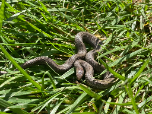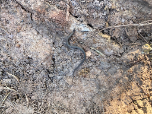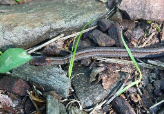 |
Black Hill Redbelly Snake Range Map
|
|
|
 |
 |
 |
 |
 |
 |
 |
Black Hill Redbelly Snake Video
|
|
|
 |
 |
 |
 |
 |
 |
 |
Black Hill Redbelly Snake Juvenile

|
|
|
 |
 |
 |
 |
 |
 |
|
Black Hill Redbelly Snake (S. o. pahasapae)
Description: The red-bellied snake is a very small snake; total body length ranges from 8-16 inches when fully grown. They are usually brown to reddish brown (although sometimes gray and rarely black) with or without 4 faint, dark dorsal stripes. Occasionally there will be only one, light colored, middorsal stripe, or all five stripes may occur together. The belly is usually a striking bright red, but is known to occur in orange, faint yellow, pink, and infrequently in gray or black. The head is usually brown or reddish brown on top with a white throat and chin underneath. There are three light spots around the neck (one on top and one on each side) that can mix together to form a collar. There are 110-133 ventral scales and 35-61 caudal scales. The midbody contains 15 scale rows. They have keeled scales and a divided anal plate.
Storeria occipitomaculata subspecies are also hard to differentiate. Some have been know to hybridize, and therefore contain characteristics of both parent species. However, the Florida red-bellied snake, (Storeria occipitomaculata obscura) usually has a more distinct neck collar (neck spots more completely fused), while Storeria occipitomaculata pahasapae of the Black Hills region has very small, faint necks spots or they are completely absen
Habitat: Habitats are varied and include mountainous or hilly woodland/forest, upland meadows and valleys, and swamp and bog edges. This snake shelters under and in ground cover, in building foundations, and in abandoned ant mounds. Generally it occurs in mesic situations with abundant ground cover.
Range: Endeminc to south-western South Dakota. Dunmire’s Lodge, Lead, Lawrence County, South Dakota
Found in these States:
SD
Diet: Eats mainly various small invertebrates, including slugs, snails, earthworms, isopods, and beetle larvae.
Reproduction: Ovovivparous. Red-bellied snakes typically mate in spring and early summer, but may also mate in late summer and fall. They give birth to live young usually between late July and early September in northern regions and sometimes later in the south. Litter size ranges from 1-21, but normally only 7 or 8 are born, with approximately equal numbers of each sex. The largest females invest more energy in reproduction, producing a higher number of young (but not necessarily larger young) than smaller females. Studies have shown that nearly all females captured in the spring are gravid, suggesting that they are very successful breeders. Female Red-bellied Snakes nurture their young in their bodies until they are born. At that point there is no further parental care
Status: Listed as Least Concern in view of its wide distribution, tolerance of a degree of habitat modification, presumed large population, and because it is unlikely to be declining fast enough to qualify for listing in a more threatened category.
»» Kingdom: Animalia - Animals
»» Phylum: Chordata - Chordates
»» Subphylum: Vertebrata - Vertebrates
»» Class: Reptilia - Reptiles
»» Order: Squamata - Scaled Reptiles
»» Suborder: Serpentes
»» Superfamily: Colubroidea
»» Family: Colubridae - Colubrids
»» Genus: Storeria
»» Species: Storeria occipitomaculata - Redbelly Snakes
»» Subspecies: Storeria occipitomaculata pahasapae - Black Hill Redbelly Snake
This article uses material from the Wikipedia article "Storeria occipitomaculata", which is released under the Creative Commons Attribution-Share-Alike License 3.0. Content may have been omitted from the original, but no content has been changed or extended.
|
|








